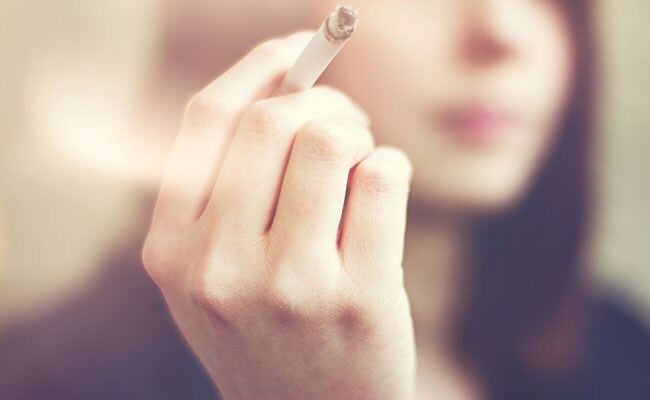Thirdhand smoke is referred to residual chemicals left on indoor surfaces by tobacco smoke. Research has shown such potentially hazardous residue can be ingested and inhaled months and even years after the smoke has dissipated.

Thirdhand smoke can increase risks of lung cancer
HIGHLIGHTS
- Hazardous chemicals often become airborne again: research
- Tobacco smoke can enter indoor spaces and cling to surfaces.
- The idea of thirdhand smoke only began to emerge in the past decade
First came doctors' warnings about cigarettes. Then came discoveries about the danger of secondhand smoke. Now, a growing number of scientists are raising the alarm about thirdhand smoke - residual chemicals left on indoor surfaces by tobacco smoke. Mounting research has shown such potentially hazardous residue can be absorbed through the skin, ingested and inhaled months and even years after the smoke has dissipated. One study this year showed third-hand smoke increased risk of lung cancer in mice. Another study last year showed liver damage and diabetes in mice. A third study this year focused on casinos and showed that six months after smoking was banned, heavy smoke residue remained on the walls and carpet.
The latest study, published Wednesday in the journal Science Advances, shows how tobacco smoke from outdoor air can seep into a nonsmoking classroom and coat its surfaces, and how those hazardous chemicals often become airborne again and circulate throughout buildings via central air conditioning systems.
"It shows that just because you're in a nonsmoking environment, it doesn't mean you aren't exposed to tobacco," said Peter DeCarlo, an atmospheric chemist at Drexel University in Philadelphia and lead author of the study. "That Uber car you jump into, the hotel room you stay in, even a classroom where smoking hasn't been allowed for decades: These are places where you are often exposed to a lot more than you expect."
The latest findings were in some ways an accident.
DeCarlo, who studies outdoor air, had teamed up with an indoor air expert at Drexel, Michael Waring, to study how the two interact. A graduate student working with them was surveying chemicals in a classroom about 20 feet from DeCarlo's office, and came across a mysterious chemical signature they couldn't explain.
At first, they suspected residue from coffee, which is ubiquitous in universities. But after a battery of tests, they were surprised to find signs pointing to nicotine and tobacco smoke residue. To replicate the chemical signature, they ran a series of experiments, blowing cigarette smoke into a glass Pyrex jar, clearing out the smoke and letting the jar sit for a week. The residue was an exact match, they found.
So they turned their investigative efforts toward the classroom, running a series of tests in which they pumped outdoor air in and out of the room.
They found that tobacco smoke can enter indoor spaces and cling to surfaces. Then, especially in summer when rooms get blasted by air conditioning, the chemicals not only become airborne again but can spread readily through the ventilation system of buildings.
"This adds a twist to what we are just starting to discover about thirdhand smoke," said Hugo Destaillats, a chemist at Lawrence Berkeley National Laboratory in California who has conducted similar research but was not involved in the Drexel study. "It shows how much we still have to learn about the mechanics of this kind of exposure."
Public health experts have accumulated mountains of data on how lethal smoking is. And they have vast data on the harms of secondhand smoke. But the idea of thirdhand smoke only began to emerge in the past decade.
Research so far on its health effects suggests it could be harmful, but data remains scarce and mostly limited to studies involving mice. What researchers are certain of, however, is that the chemicals from tobacco smoke often linger on clothes, surfaces and even skin.
Public health advocates worry that those most vulnerable to the harmful effects of thirdhand smoke are also those who most likely to come into contact with it. A baby crawling on the ground, for example, has much more contact with carpets where cigarette residue often resides. And because of increasing socio-economic disparities in smoking, low-income families are more likely to live in homes and neighborhoods where decades of smoking have led to thirdhand smoke accumulation.
"I don't think we have a clue how big the problem is," said Matthew L. Myers, president of the Campaign for Tobacco-Free Kids. "It's impossible from the science so far to say how widespread and serious the risk is, but what we've seen already only adds to the reasons smoking should be banned in public places."
Growing research on such residue has prompted legislatures to consider laws banning smoking on premises like child-care centers, even after-hours when no children are present.
The American Academy of Pediatricians has issued recommendations to limit children's exposure to thirdhand smoke. And in recent years, California has created a new consortium of scientists funded by the state's cigarette taxes to research the mechanics and possible dangers of thirdhand smoke.
(This story has not been edited by NDTV staff and is auto-generated from a syndicated feed.)
DoctorNDTV is the one stop site for all your health needs providing the most credible health information, health news and tips with expert advice on healthy living, diet plans, informative videos etc. You can get the most relevant and accurate info you need about health problems like diabetes, cancer, pregnancy, HIV and AIDS, weight loss and many other lifestyle diseases. We have a panel of over 350 experts who help us develop content by giving their valuable inputs and bringing to us the latest in the world of healthcare.














